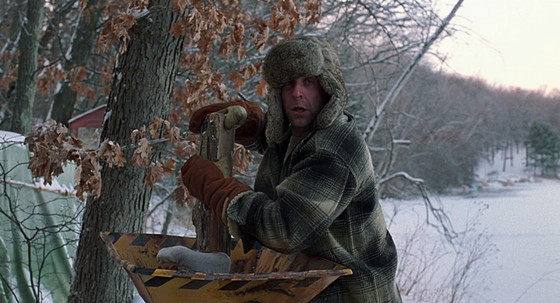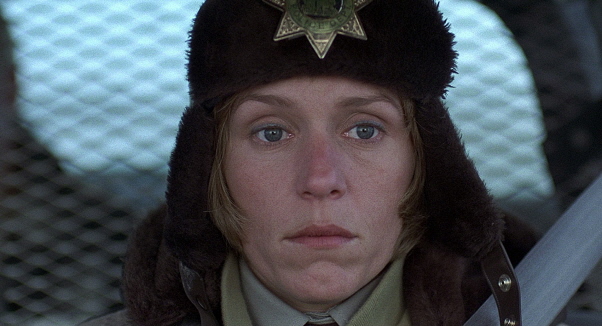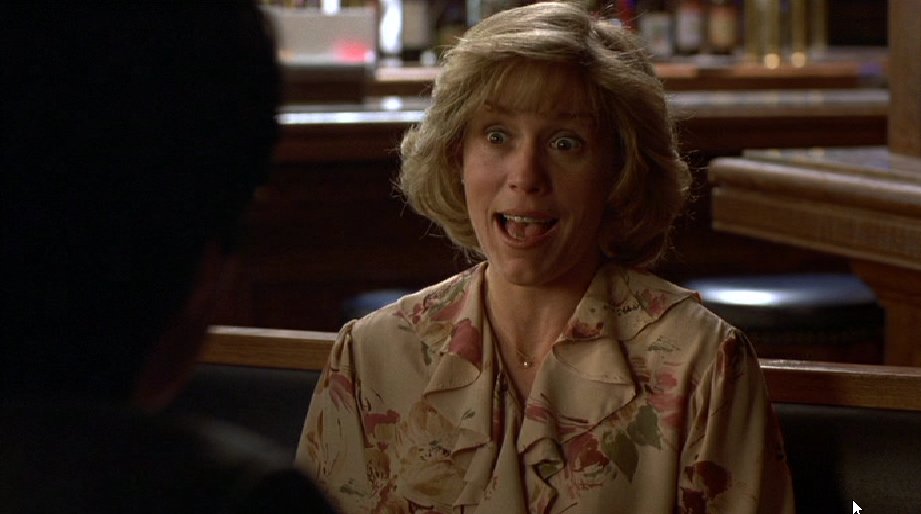4. Strong villains make a strong film

The ‘bad guys’ of this film have already been introduced, but they bear further examination since they are the mainspring of the story. In many films, such as classic Hitchcock or James Bond films, the villain is usually some ultra-smart, ultra-bright, ultra-manipulative, really quite worthy foe of the law.
The remarkable thing about “Fargo” is that its villains aren’t any of these things. In fact, they are the exact opposite of these tropes, yet the filmmakers still manage to make them interesting… or their actions, anyway.
The Coens recognize that ignorant, limited people can often be very violent forces. Such people are often quite fearful and don’t have the brainpower to think their way out of difficult situations other than to do something extreme and harmful, something which usually, if the perpetrator were thinking clearly, would be seen as counterproductive, if not downright destructive.
Observing the two ‘hired guns’ in “Fargo” illustrates this point perfectly. It’s pretty easy to imagine their whole lives just by studying their behavior over the short time in which the film takes place. Showalter probably spent his life trying to pull off some con he considered to be slick but which was undoubtedly something many had tried and failed many times before.
Yet, he has persisted in a life of petty crime knowing that the big score that will set him up on Easy Street is right around the corner. Throughout the film he makes one jaw-droppingly bad decision after another, such as trying to steal/switch license plates in a parking lot that has camera surveillance. Unfortunately, such actions inevitably involve his partner in crime and cause him to act accordingly.
It’s also rather obvious that Grimsrud has spent his life being derided as a dim bulb and having to redress the balance of his mental deficit with the brawn his hulking physique affords him. In other words, he would literally just as soon kill as look at anyone and, well, quite often does. His partner’s bad choices seem to provoke him to kill quite a bit. In fact, the most remembered image from this film involves the character’s nasty use of a wood chipper.
The Coens underline the banal/evil concept of these two with a drolly funny episode showing them mirthlessly cavorting with two ladies of dubious virtue, and following it up with an aftermath which can best be labeled as mundane. However, though the activities of these two provide a lot of action and amusement (though, admittedly, some early audiences weren’t quite so amused by the violence), the true villain is the one behind the scenes.
Lundegaard would likely not consider himself a villain. It is doubtful that he ever had done anything criminal before planning this dubious caper (and equally doubtful that he ever done anything greatly good, either). It’s pretty plain that he has no real head for crime; in fact, part of his payoff to the hard-luck pair of kidnappers involves a stolen car from his lot. For some unknown reason, he thinks no one will notice it missing or would ever be able to trace it.
When things start hitting the fan it’s equally clear that he was so sure of his makeshift kidnapping plan that he never considered a Plan B when or if things start to go wrong. So he starts to lie… and lie… and lie. It should be added that he is not any good at lying and no one has ever sweated more while doing it. And when he gets good and cornered, he does the worst thing he could do… he runs away, foolishly thinking he can outrun the law and/or the criminals in which he’s involved himself.
Honestly, he’s more pitiful and annoying than anything else (and his exit scene truly points this out), except for one big thing: his greed and stupidity are the underlying causes of a plethora of violence, death, and tragedy. No, he didn’t have some grand plot to steal millions, take over great corporations, or seize the rulership of great nations.
However, a dense plan to steal enough money to buy some parking lots in a forgettable corner located in a patch of nowhere can, as it so happens, serve the purpose quite nicely.
5. Enter the agent of the law

With this entry, the catalyst for the elements that make “Fargo” come together is introduced. Coming at a point well over the half-hour mark (a long time in a film of rather average length), the agent of the law, the force returning order and sanity, is finally presented, and it is truly unexpected.
A middle of the night call is placed to the local sheriff. The couple in bed at the sheriff’s house consist of two people in their early middle years; neither appear to be glamorous, though the husband (John Carroll Lynch) seems a sturdy type. However, he paints decoy ducks for a living.
The wife is the officer of the law. She is also about seven months pregnant. When she speaks, it’s also obvious that she isn’t some sharp high roller brought in some a big city on either coast, but rather a homegrown talent. Her name is Marge Gunderson (played by – who else? – Ms. McDormand) and she is not to be underestimated.
That is not to say that many wouldn’t try to underestimate her. Is she a tough cookie? Well, certainly not at first glance. Does she seem to be smarter than her surroundings? Well, not at first glance there, either. She needs her husband to jump-start her police car in the cold and looks to be quite devoted to their warm little nest of a home.
However, she doesn’t complain about having to go out in the middle of the night to do her job and she never uses her condition as a crutch. In fact, she doesn’t really mention it, nor do the filmmakers, really. It is an unstressed, lifelike detail.
She will not go into labor at a crucial moment in the film and will not give birth during the course of the proceedings (and the viewer will never know a thing about the eventual baby). However, while watching her work, a few things do become clear. Marge may not be at all worldly and she speaks in the odd-sounding dialect of her homeland, but she is far from stupid.
At the scene of a crime, she almost immediately analyzes several key factors concerning the culprits and clues to the resolution, things her male colleagues miss or get wrong.
Her basic goodness and honesty may prevent her from connecting the dots right away, but when she does, she ties up the situation quickly against daunting odds. In the end, she gives the criminal she apprehends a lecture while driving the police car, which surely washes over him but tells the viewer volumes about her. She may look and act funny, like so many others around her.
It’s hard to say what it took for her to get to the position she holds since she is initially so unprepossessing. She may or may not have education. She has no sophistication. She is far from a Type-A personality. She may not have gotten around much, but she has tremendous native intelligence and integrity. In the end, she’s a great person to have in charge.
As an aside, McDormand is also nice to have around; though she’s no great beauty and is viewed as a great character actress by most in the film world, she is a most worthy actress to play leads, and here to Oscar-winning effect.
6. That certain scene makes a big difference

There is one scene in “Fargo” that causes endless head scratching. Many don’t get why it’s even in the film. However, in the end, this scene perfectly shows the Coen brothers’ quirks and cleverness and really makes the film what it is.
Taking time out from the case, Marge meets up with an old friend from school for dinner. In a typical Coen touch, he’s Asian-American (played by Steve Park), though he speaks in the same Scandinavian-influenced way as most of the other characters. He goes into a long tale of all of his accumulated woes since high school, obviously aimed at garnering Marge’s sympathy (though the reason for that is kind of opaque). The thing about it is that the next morning, while talking to another mutual friend from the old days, Marge discovers that the man was telling her a pack of lies.
Now, if Joel Coen had inserted a close-up of Marge making a face like she had a light bulb going off in her head, which would have been pretty cartoonish, then it might have made more sense to the public. Instead, Marge keeps saying in a dazed way things such as “oh, geez” or “yah”. The point that’s being made is that Marge couldn’t quite figure out the case because she was thinking that everyone (mostly Lundegaard) is telling the truth.
The false versions of all the events which she is being given aren’t adding up. However, she has been presented with someone who told her needless lies for reasons that she (and the viewer) don’t really understand. It finally dawns on her that someone with way more at stake must surely be lying. Now, doubting everything that she has heard, she is ready to approach the crime again and look at it in a new way.
Many missed this because they failed to look at things from the character’s perspective. Marge may not have automatically known the way, but once she finds the path, she makes up for lost time. This type of original observation and unique wrinkle is part of what makes the Coens great.
7. In the end, it’s all about Joel and Ethan Coen

There are, as hopefully shown in previous entries, a lot of interesting elements in “Fargo” and in any other film from the Coen brothers. That said, the big selling point of a film by the pair is that, in the end, it’s one of their films. While many filmgoers look to see what actor may be appearing in a particular film, many film-savvy viewers (and there are a lot of them nowadays) look to see who was behind the camera.
There are filmmakers such as Tim Burton who almost exclusively one type of film (absurdist fantasy), and others such as Clint Eastwood who vary things a bit (though his films always seem to embody a tough, masculine edge). However, it’s hard to think of a filmmaking combo that shows more versatility than these brothers, who are still are so distinctively themselves in film after film.
Those who believe in the auteur theory could easily connect the dots between, say, “Blood Simple” and “No Country for Old Men”, and easily find the family resemblance between “Raising Arizona” and “The Big Lebowski” but it would take a bit more intellectual digging to put them all together as the works of the same cinematic authors.
“Fargo” seems to be the missing link among them. It has the pair’s trademark fish-eyed, deadpan humor; the accurately observed, carefully contexted violence; and their often overlooked sense of humanity (often a bit muted, admittedly). They are among the true originals in filmmaking history, let alone current cinema. No filmmaker really tries imitate them, nor could they.
By the same token, the Coens should stick to their own muse. For many, the low point of their careers was their 2004 remake of 1955’s “The Ladykillers”, a wonderful film by British director Alexander MacKendrick, another true cinematic original.
Though they tried to insert their own touches, it was basically someone else’s dream. In contrast, their 2010 film “True Grit” was their own version of their own version of the Charles Portis novel, not a remake of the original 1969 Henry Hathaway film, and thus, it did work.
Their recent film “Hail, Caesar!” seemed to have half of the Screen Actor’s Guild in the cast, but in the end, it was sold as a Coen brothers film, not on the basis of anyone in it or even what the film was about. (Based on past history concerning their comedy films, it might be a good idea to keep an eye on the future reputation of that indifferently received picture.)
All this being stated, “Fargo” still stands as one of the finest hours in their canon. That makes it one of the outstanding ones in film history.
Author Bio: Woodson Hughes is a long-time librarian and an even longer time student/fan of film, cinema and movies. He has supervised and been publicist for three different film socieities over the years. He is married to the lovely Natalie Holden-Hughes, his eternal inspiration and wife of nearly four years.